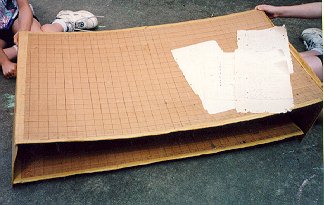Subsim Latest Articles & Reviews
Jump to navigationThe SUBSIM ORIGINAL (The Submarine Game)
Subsim founder Neal Stevens was interested in subsims before there were personal computers--he built one when he was a kid. The playing board consisted of two sheets of heavy cardboard, 20 inches wide by three feet with an elaborate structure of turn-based conditions and outcomes using dice and cards.
NEAL'S SUBSIM ORIGINAL
![]()
COMPANY: Young Neal
Requirements: Two decks of cards, six dice
PLATFORM: Any ol' table will do
 What you see before you was created about 27 years ago and never made it out of the beta stage due to a lack of qualified testers. Usually referred to as "The Submarine Game," Neal's SUBSIM Original predated Windows 95, DOS, and BASIC.
What you see before you was created about 27 years ago and never made it out of the beta stage due to a lack of qualified testers. Usually referred to as "The Submarine Game," Neal's SUBSIM Original predated Windows 95, DOS, and BASIC.
This was analog in every sense of the word. The original was recently dragged
out from the dark recesses of my parent's attic to shine in all its glory as a
momento of my yearning for an authentic submarine simulation.
The rules were simple. Simply overwhelming, that is. In order to make as many facets of the game as realistic as possible, the creator devised an elaborate structure of turn-based conditions and outcomes using dice and cards. The playing board consisted of two sheets of heavy cardboard, 20 inches wide by three feet. The surface of each sheet was marked off in a grid, each grid identified by a letter/number system. One sheet of cardboard had three panels that served as legs, and it stood astride the other creating a two-dimensional playing field. Two players, one a sub skipper and the other an escort commander, competed against each other for oceanic dominance. The game used surface ship and submarine tokens stolen from my Battleship game. The sub
skipper had the option of diving below the surface, which meant he moved his piece to the bottom deck and accessed it from the open side, while the three panels concealed his exact whereabouts from the surface ship player. The escort commander directed the surface ships, usually four merchants and two destroyers, sometimes a battleship as well. Played in turns, this early analog subsim was very dependant on rules.

There were eight
sheets of "Turn Outcomes" to follow. Using six dice and two decks of cards as
the "computer", the surface player would roll first one dice to determine how
many squares to move, and then the rest to determine how many ships would move.
The merchants were limited to one grid per move, the escorts the rest of the
total. In the sub player's turn, he rolled dice in a similar fashion, but was
limited to half the total while underwater. The players could substitute other
actions in a turn, such as changing depths, firing guns, depth charges, and
torpedoes. Submarine depth was kept secret from the surface player on a small
cardboard gauge, and relied on the honor system. When a player decided to fire
a torpedo or depth charge, he had to declare the depth, grids targeted, and
draw a card from the deck to determine the outcome of this action. For the
surface player, the objective was to cross the board with his pokey convoy
with minimum losses, and try to sink the sub. The sub player was charged with
sinking everything possible.
Although I built this "subsim," labeled and hand drew the card suits on the outcome sheets, and devised a set of equitable rules, it didn't see very much gameplay. No one in my household shared my enthusiasm for battlesea warfare, and my friends complained the rules were way too complex and hard to follow. Fair gameplay relied heavily on the honor system ("I said I dropped charges at 200 feet! What depth were you at?" "Uh ... 300 feet!") to be functional. Thank God that computers were invented! My dinosim depended on dice, imagination, and honesty. Now the computer functions as the impartial referee, the random outcome generator, and throws out real time graphics and sounds to boot.
